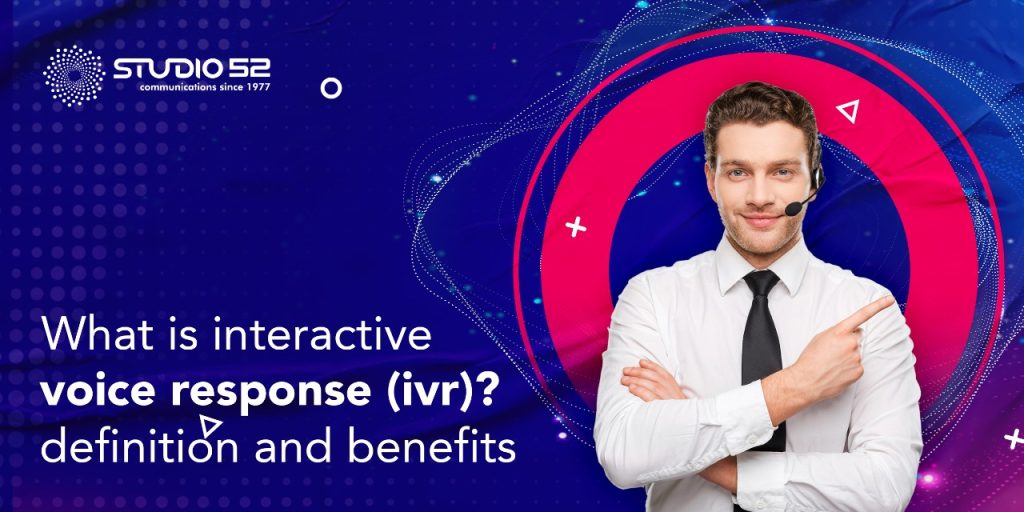Interactive voice response is a technology that has become a key component in the communication model used by most businesses today. Originally designed to order custom products, it has now become one of the most widely used tools in customer service.
This system is more efficient than traditional customer service methods, and it is easy to customize to meet the specific needs of each business. So, to know more about IVR and how it can benefit your business, continue reading without further ado.
Table of Content
What is Interactive Voice Response (IVR)?
IVR, or interactive voice response allows customers to interact with a computer system using their voice. Organizations commonly use it to automate repetitive tasks, such as making payments or checking account balances.
IVR systems can also be used in call centers to route calls to the appropriate agent and provide caller ID information. This technology is typically used with other customer service technologies, such as live chat and email.
IVR systems are typically managed by a service provider, who will install and maintain the system for the organization. It offers operators various benefits, including reduced operator cost of ownership, increased sales, and improved employee productivity.
Growing Popularity of IVR
You can now find an IVR system in almost every modern car and home because it is used to do everything from checking the oil level to requesting help when the car breaks down. It can be a valuable means of communication between people, and allows them to interact.
It has become more prevalent in recent years because it can be very effective in helping users manage their medical conditions. These systems are now being used in hospitals, clinics, businesses, and homes to help people resolve problems.
What are the Benefits of IVR?
IVR offers several benefits to businesses to interact with customers in a more personal way. Here are a few of them:
It is easy to scale up to many customers
To scale up an IVR system, it is important to have a good understanding of the market. To do that, you need to know what you are trying to reach and what your customers want.
The first step to do that is to get a simple consumer survey. It will tell you who your target market is and if the product line has any shortcomings which need to be addressed.You can also look at what other companies are doing by looking through their recent results, trends, and backlogs.
The more information you gather on how people are using your device, the better position you will be in when entering to new territories.
The administrative costs of IVR are low compared to traditional telephone
A lot of companies use IVR to generate reports or to automate tasks such as emailing. The cost of IVR is lower than that of traditional telephone, and this makes it a great option for small and medium-sized businesses.
The telephone system allows you to keep your costs low by keeping direct contact with the customer, while IVR is more convenient and reliable.
If a problem arises during the communication process, an operator can get back to you immediately with the option of connecting you directly to the company’s sales representative or customer service representative.
It is best for a closed-loop system, i.e., a continuous flow of messages
With IVR, you can generate a closed-loop system for a particular product or service. This is because the user can interact with the system and follow the specific guidelines & actions suggested by the system.
The system can then make recommendations and generate suggestions that are more personalized, efficient & effective. IVR allows you to respond in a single session and gather feedback from your visitors which enhances your marketing goals and customer experience.
IVR is easy to use in a cooperative or multi-user system
IVR is a simple way for users to interact with an automation system. It allows them to ask the system questions and get answers back. You can then send that data to a database or another program for further analysis or create an action plan, which is an executable script people can download and run on the automation system.
These actions allow the user to execute certain actions on the automation system in order to solve certain problems. If a user accidentally breaks something or presses buttons incorrectly—it doesn’t matter, because you’ve already programmed an action for that specific scenario!
IVR is easy to automate
You can automate IVR using either HMI or a user interface. In HMI-based systems, the integrated voice and handwriting recognition system is used to handle customer service requests. The audio portion of the IVR system comprises basic prompts, such as phone numbers and contact person information.
You can read aloud handwritten letters to the customer in order to confirm their request or provide additional information needed by the call center agent recording the call. Then you can send this recorded information to the call center agent through a special device.
Uses of IVR
Using IVR has been increasing over the years. It is one of the most popular ways to reach out to customers and prospects. With the rise of digital communication, it has become more important to have a good experience when interacting with customers. IVR is one of the key tools that are used to provide this experience.
Customer service
IVR is a very popular way of delivering customer service in a variety of industries, including banking, retail, transportation and utilities.The IVR system comprises an audio connection between the customer and a salesperson.
The salesperson speaks to the customer through a microphone and an electronic device that records his or her voice for future calls. The salesperson does not speak directly to the customer; instead, he or she just listens to what the customer says.
Sales calls
Interactive voice response (IVR) is a method of accessing customer service support by using an automated system. The IVR is used most in the telemarketing industry, but it is also used in many other areas, such as business sales calls, advertising, greeting messages, and so forth.
The system is used in almost every business to contact customers and prospects directly.IVR offers the potential to build a big database of contacts for sales managers. Having that much information on these people is a great help for the sales department.
Telemarketing
In call centers (where customers talk with representatives), IVR is used as part of telephone systems where one representative answers calls from various customers. Internet call centers or VoIP call centers (also known as virtual interview rooms) are called by a dial-in number.
Both the telemarketer and the person on the other end of the line speak to one another using voice recognition. In these calling centers, a customer-agent prepares an order for goods and services from a remote seller – from an eCommerce platform, via a website or via phone lines.
E-meeting
Using IVR in an e-meeting room is not as old as the Internet. But it has been around for a long time and its usage has increased over the years. IVR systems handle the hands-free voice usage and output of all kinds of information, such as a sales report, an appointment setting request or a customer service call.
It provides more convenient and reliable user experience than SMS/MMS systems. A user does not have to press any buttons or use any other methods to get an answer through the IVR system. Thus, the most important aspects of IVR is its accessibility, ease- of-use and clarity.
Drawbacks of IVR
While IVR has been a great success for businesses, it has also created a lot of challenges for marketers. The main problem with IVR systems is that they require users to be at the right place at the right time which means that it is of no use in places where there are no users or too many users.
In addition, it is difficult to create an effective IVR system without having access to advanced tools like speech recognition technology and natural language processing algorithms – which makes this system even more expensive.
Why Are Businesses Investing in IVR?
Businesses are increasingly investing in IVR (interactive voice response) solutions to get the best possible customer response, time and maintain high call-to-call ratios. Therefore, it is important for businesses to run as efficiently as possible by eliminating unnecessary expenses related to telephone numbers and increasing revenue by selling more useful information through IVR.
Here are a few of the reasons businesses are investing in IVR:
- It is more cost effective than a desktop system.
- Since the IVR systems have no screen, there is no need to do any screen training.
- IVR systems are very user friendly for customers.
- With the help of IVR, businesses can look up their information and make changes easily via their phone, rather than being confined to a screen that is hard to read.
IVR Mobile Applications
IVR Mobile applications are increasingly becoming a popular way to interact with customers. They can help you automate your business processes and deliver better results to your users.
E-learning IVR Apps
E-learning is learning through instruction, study and practice. It is a key component of the overall education system. You may use it for skills development, transferable skills to job or career, as well as for personal growth and development.
The trend in e-learning is to use interactive voice response (IVR) platforms to engage learners in learning activities such as group seminars, self-paced modules, and learning group activities where the learner selects from a list of options, which are then recorded and analyzed.
This learning is done without the use of any means such as paper or pencil, allowing online learning content to be used with minimal effort and time.
IVR mobile Apps Used by Companies to Track Overseas Sales
Companies use the IVR mobile apps to track overseas sales, monitor sales in different countries, and provide reports on performing overseas sales. In fact, some of the IVR mobile apps are now easy to integrate with Salesforce CRM so that you can create new leads in just minutes from your Android or iPhone device.
With an IVR app installed on your phone, you can easily connect to Salesforce CRM, provide your contact information and make immediate edits or other customizations in Salesforce CRM.
For example, you can set up a new lead in the dashboard of your custom contact record that automatically triggers an IVR app connection with Salesforce CRM. Or, if you have a customer relationship manager installed on your smartphone, you can see the information on that customer’s behalf so that they can quickly update their account in Salesforce CRM.
How to Choose the Best Interactive Voice Response System for your Business?
In order to choose the best interactive voice response system for your business you need to consider some important factors such as following:
- Speed of operation–How quickly can the system work?
- How fast can you receive and process calls from your callers? Also, is that speed of operation acceptable for your organization?
- How quickly can the system work?
- How fast can you receive and process the data?
- How do we define speed, or service time?
This will help determine how many people you can handle at a time and what could be the best approach for your organization.
Tips & Best Practices To Implement An IVR System
IVR can be a helpful addition to any business; however, there are a few things to keep in mind before implementing it.
- First, it’s essential to understand IVR and how it works. IVR is an automated system that uses pre-recorded voice messages to interact with callers. It allows businesses to route calls more efficiently and free up employees for other tasks.
- Second, the system must have enough memory to store all the information received from the customer before you send it to the operator. The more memory available in the system, the more accurate will be its results and hence easier it will be for operators to process incoming calls and messages.
- Third, for an IVR system to work properly, there should be a way of connecting with an external server which can provide technical support and help in solving problems like low battery level or connectivity issues.
- Fourth, there should also be some way of controlling how much time is allotted for each call so that operators can keep their attention on the customer.
- Finally, ensure that IVR system is configured correctly before launch. Otherwise, you may end up frustrating customers and losing business. To avoid this, work with a reputable IVR service provider like us who can help you set up and test your system before going live.
This is how with a bit of planning you can ensure that your IVR system is valuable to your business.
Bottom Line
Interactive voice response systems is a powerful technology used for customer service, marketing, and surveys. There are many different IVR systems, each with its benefits and drawbacks. Still, the future of IVR looks bright as it continues to evolve and become more sophisticated. Contact us, and we’ll help you boost your business by implementing an IVR system into it.






